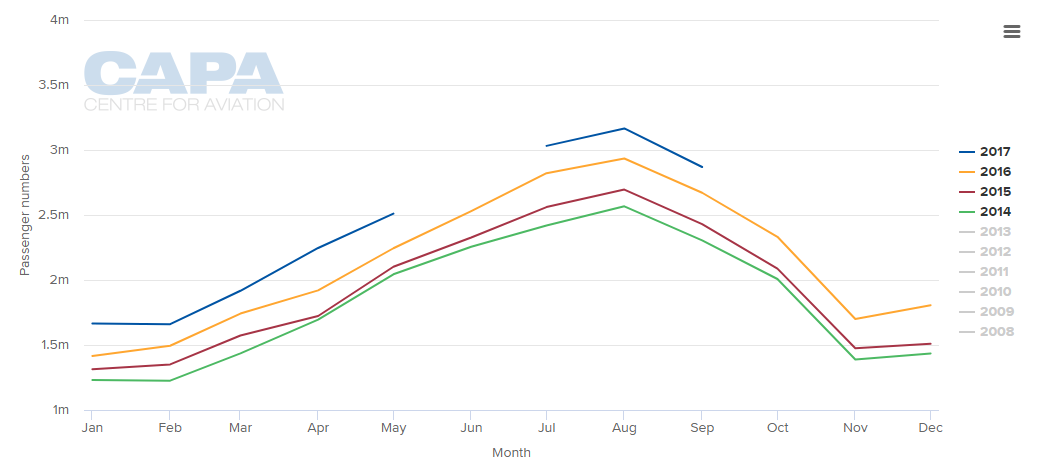In recent years, the UK has been the second most popular global destination for international students after the USA. In 2015 there were around 200,000 foreign students arriving in the UK, eight times more than the 25,000 UK residents studying abroad. Manchester itself claims to have the largest single-site university campus in the UK, and a total student population of 100,000, many of whom will be foreign. Manchester is also the primary global gateway to universities and colleges in Liverpool, Preston, Lancaster, Leeds, Bradford, Huddersfield York, Sheffield, Hull, Durham, Newcastle, Stoke, Keele and several in Wales. Also, to a lesser degree, Nottingham, Derby and Loughborough and even some Scottish universities.
MAP - Manchester is the largest airport in the north of England providing good connectivity options to the north and south and even into Scotland and Wales Source: Google Maps
Source: Google Maps
The number of foreign students in the UK is actually falling since 2016, which was the first time in five years - possibly in anticipation of 'Brexit' - but that was undergraduate students. There are also considerable numbers of postgraduate students and, at the other end of the scale, those attending English language colleges, of which there is a glut, mainly in the larger cities
Moreover, throughout the year there are study visits, staff and student exchanges, consulting assignments, and a raft of other factors underpinning the importance of academia in the airline and airport passenger mix.
There is additionally the potential for a spin-off in the form of families travelling with the student, or joining them for a period of time. This is most likely to happen with postgraduate and research students, who may also work part time in knowledge industries (as opposed to undergraduate students who tend to work in casual employment).
This sudden September influx of students is not reflected in Manchester Airport's overall monthly traffic chart graph, which shows the same August peak and subsequent September decline year on year. In fact the general increase in passenger traffic there in Sep-2017 was lower than in Sep-2016 by 2.5 percentage points.
CHART - Manchester Airport sees a peak in demand during the summer months and its September performance is likely influenced by foreign student arrivals Source: CAPA - Centre for Aviation and Manchester Airport reports
Source: CAPA - Centre for Aviation and Manchester Airport reports
However, if the international passengers are segregated, the increase in Sep-2016 was 24.4% and it is quite possible that foreign students played a part in that.
The UK's second-largest student city, with five universities in the region, is Birmingham. Its airport displays a similar curve to that of Manchester with a decline in overall passenger numbers from September onwards but the recorded growth in those passengers in 2016 was 15.9%; higher than in August. Again, student arrivals may well have played a part.
Comparing these airports with others in mainland Europe, The Blue Swan Daily has taken a selection from the Top 10 European student cities from the QS Top Student Cities guide 2015. The criteria for inclusion are 'affordability' (fees can be as low as zero in some cases), a large student community, quality of living and career prospects. In other words they are international cities that for various reasons are attractive to foreign students.
Three of them are in the UK - London and Edinburgh along with Manchester, so are omitted. The others are (in order) Paris, Zurich, Munich, Berlin, Barcelona, Vienna and Copenhagen. Where there is more than one airport, the largest was selected. The analysis was for traffic growth in the months of Jul-2017, Aug-2017 and Sep-2017 except in the case of Berlin Tegel (no Sep-2017 data so 2016 data selected instead for all three months).
TABLE - Passenger demand has risen by a greater rate in Sep-2017 versus Aug-2017 at three of the top European student cities Source: CAPA - Centre for Aviation and airport reports
Source: CAPA - Centre for Aviation and airport reports
Where traffic growth has been highest in September it is shown in bold. In all but two cases the downward trend of total passenger numbers from September was observed. Those cases are Munich and Berlin. In three of the last four years Munich's traffic has risen by a greater amount in September than in August, as was also the case in Berlin in 2014, 2015 and 2016.
But there may be other contributory factors in those cities, such as strong outward demand and local festivals. There is also the propensity for one-off events to skew the data. For example, while it is not relevant to this particular study, traffic at Paris Charles de Gaulle airport collapsed in Sep-2014 but it was not as a result of terrorist activity (which has impacted aviation greatly in France) but rather an Air France pilots strike.
The only conclusion that can realistically be made here is that there is no conclusion. There is some evidence that international passenger traffic is boosted by student travel at the beginning of academic years. (It may not be as obvious at the end of the year as some will stay on and return journeys may be staggered). But the evidence is not entirely convincing and an in-depth study may be called for.